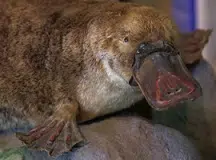 The platypus is an animal that belongs to the group of mammals . Its name comes from the scientific Latin ornithorhynchus , a word that in turn derives from the Greek terms ornitho and rýnchos .
The platypus is an animal that belongs to the group of mammals . Its name comes from the scientific Latin ornithorhynchus , a word that in turn derives from the Greek terms ornitho and rýnchos .
This species is part of the group of monotremes : they lay eggs and have a beak like birds, although their young feed on the milk that flows from the mother's breasts . When examined closely, the beak is not the same as that of a bird because it is covered in hair. The members of this order also have a cavity known as the cloaca , where the reproductive, urinary and digestive tracts converge.
In addition to a beak, platypuses have webbed feet and a flat, elongated tail, very similar to that of beavers. Its body, on the other hand, is covered with fine, grayish fur. Its skeleton is more similar to that of reptiles than to the rest of the animals of its genus.
Just like certain rodents , the platypus has pouches , bags that are in its mouth and uses them to preserve food until the time comes to eat it. The size of its body is relatively small: its length is between 45 and 60 centimeters; Regarding weight, males can measure between 1 and 2.4 kilograms but females between 0.7 and 1.6 kilograms.
Another peculiarity of platypuses is that they are poisonous . Male specimens have a spur on their hind legs that releases a poison. Platypuses inject this substance into other males to take care of their territory, especially during the mating season.
The person who is attacked by a platypus and receives its poison experiences intense pain. Given the low level of toxicity , however, this poison is not fatal to humans.
Platypuses, endemic to the eastern part of Australia as well as the island of Tasmania, live in river and stream areas as they are semi-aquatic and excellent swimmers. More specifically, their habitat is complex tunnels with many galleries that can measure up to thirty meters and they dig them themselves near the banks. They feed on fish, insects and larvae, while their predators include eagles, hawks, owls and snakes.
 Although it is not at risk of extinction , the platypus is protected in its habitat due to its vulnerability to pollution and other factors. Additionally, captive breeding programs have not been very successful. Until the beginning of the 20th century, it was the focus of hunters for its skin, but fortunately this ended when it became a protected species.
Although it is not at risk of extinction , the platypus is protected in its habitat due to its vulnerability to pollution and other factors. Additionally, captive breeding programs have not been very successful. Until the beginning of the 20th century, it was the focus of hunters for its skin, but fortunately this ended when it became a protected species.
After a gestation that lasts 28 days, the female lays her eggs and incubates them for a maximum of ten days. It usually puts between one and three, which remain adhered thanks to the presence of a viscous substance.
As if the appearance of the platypus and its way of reproduction were not strange enough, it is one of the few animals that does not have a stomach. There is nowhere between your throat and your intestine where acid is produced to digest food. There are several vertebrates that in the last two millennia began a process of "loss" of the stomach, and this group includes the echidna (the closest relative to the platypus), the dipno (a vertebrate fish that can breathe out of water) and the chimera (shark-like species).
The first platypus fossil is approximately one hundred thousand years old, from the Pleistocene period. The extinct genera Steropodon and Teinolophos of monotreme mammals were closely related to the modern platypus.
